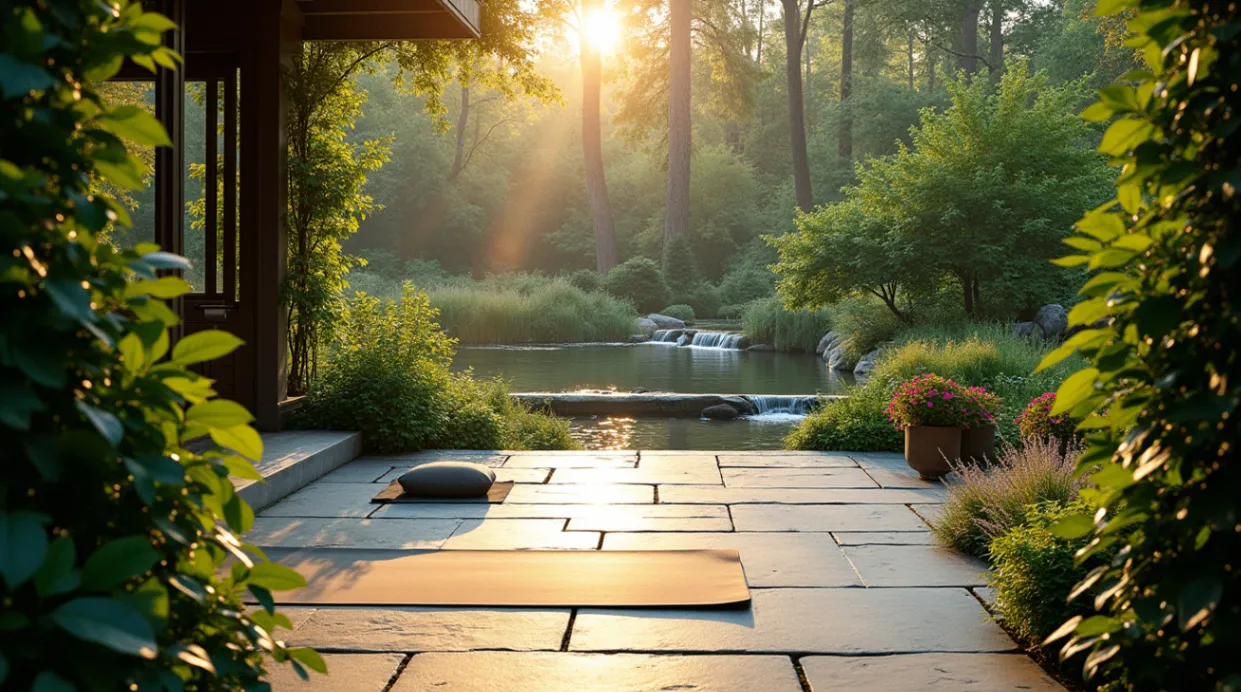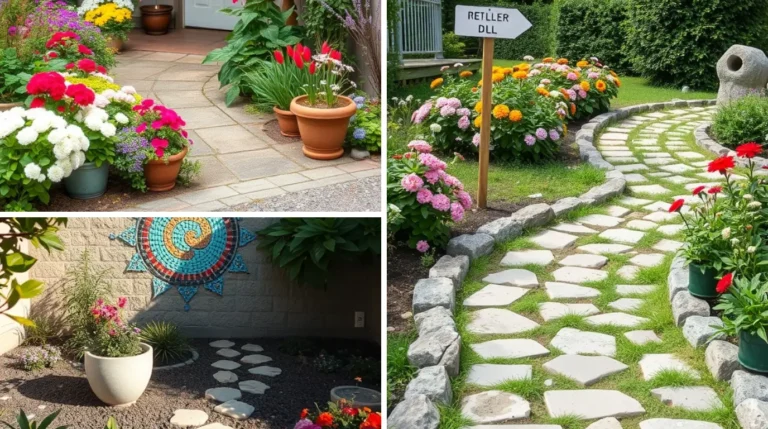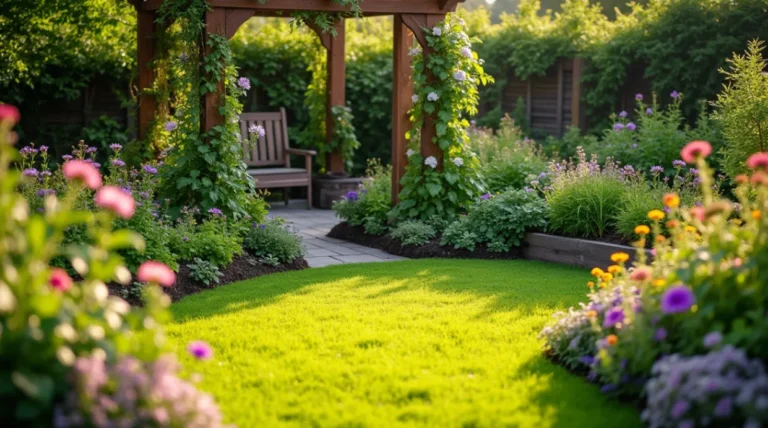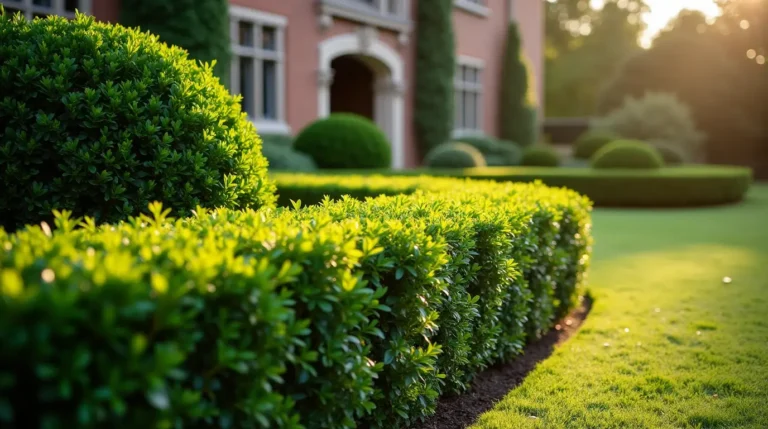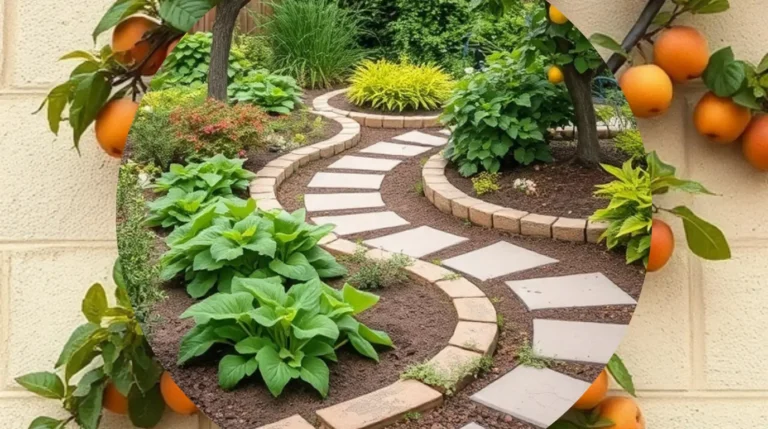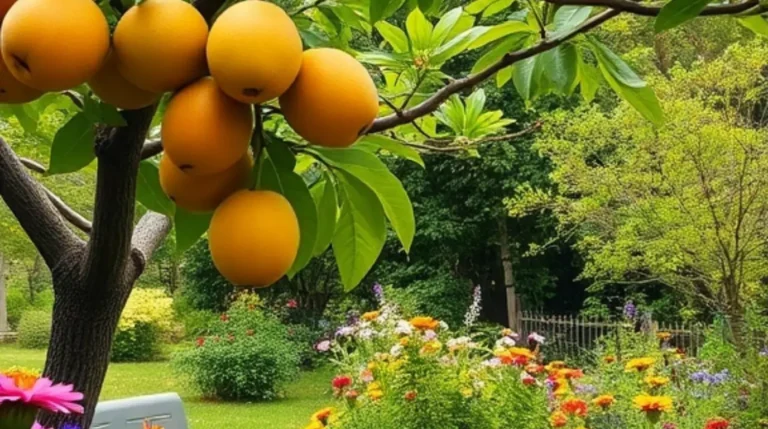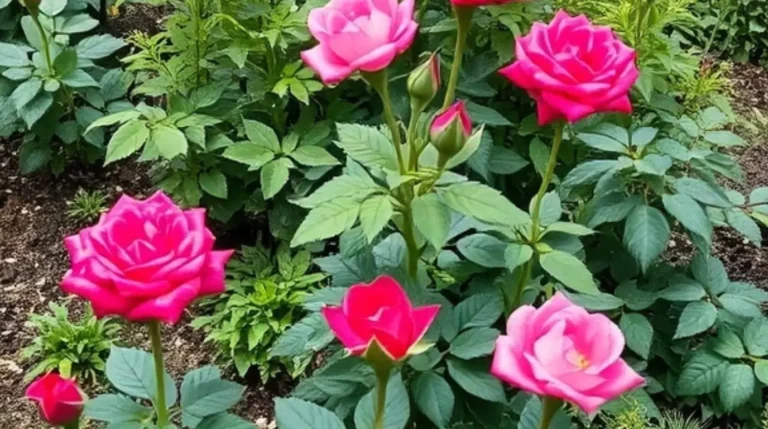Tranquil Outdoor Yoga & Meditation Garden Ideas
Creating a serene outdoor space for yoga and meditation can greatly enhance one’s mental and physical well-being. A thoughtfully designed garden offers a tranquil escape from daily stress. It allows individuals to focus on their breath and connect with nature.
Incorporating garden ideas such as water features, natural elements, and seating areas can create a tranquil atmosphere. This is perfect for outdoor yoga and meditation practices.
Imagine practicing yoga surrounded by lush greenery and the soothing sounds of nature. Or meditating near a calming water feature. Such a space can help individuals cultivate a deeper sense of inner peace and balance.
By incorporating outdoor yoga into a meditation garden, individuals can experience the numerous benefits of both practices. This includes reduced stress and improved overall well-being.
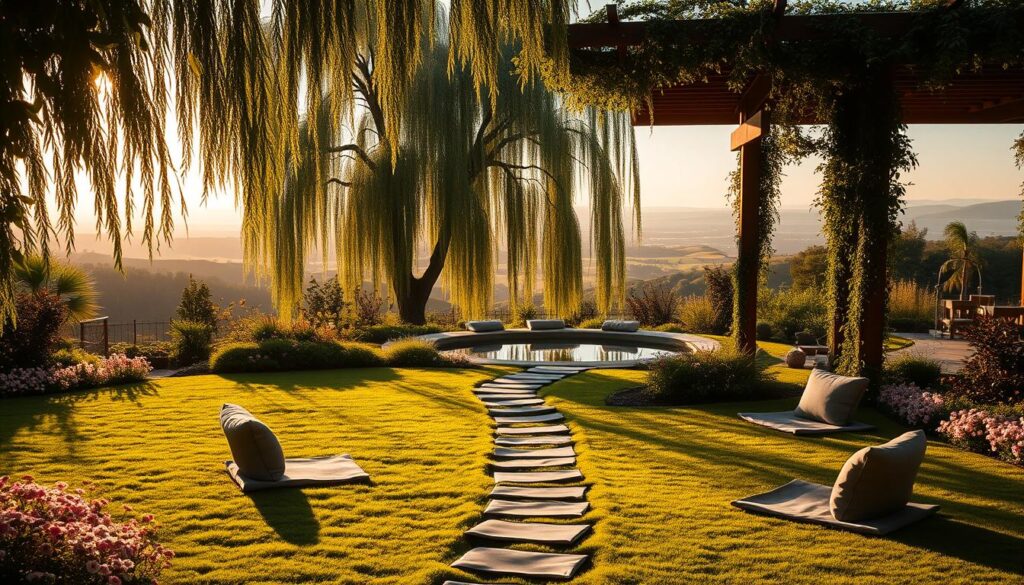
When designing a meditation garden, it’s essential to consider the essential elements that will create a peaceful and calming atmosphere. This includes incorporating natural elements, such as plants and trees, and creating a sense of balance and harmony.
By doing so, individuals can create a serene outdoor space. This space fosters a deeper connection with nature and promotes overall wellness through outdoor yoga and garden ideas.
Key Takeaways
- Creating a meditation garden can enhance mental and physical well-being
- Incorporating natural elements and water features can create a tranquil atmosphere
- Outdoor yoga can be a great way to practice in a serene and peaceful environment
- A well-designed garden can provide a peaceful retreat from everyday stresses
- Garden ideas such as seating areas and walking paths can enhance the meditation experience
- Outdoor yoga and meditation can help reduce stress and improve overall well-being
Understanding the Elements of a Meditation Garden
Creating a meditation garden needs careful thought about different elements. It’s key to include garden ideas that help people relax and feel calm. A well-made meditation garden is a peaceful spot where people can connect with nature and themselves.
A meditation garden usually has plants, water features, and places to sit. It’s important to mix natural and made elements well. This way, the space feels welcoming and organic. With these elements, people can make a meditation garden that brings calm and peace.
Essential Components for Spiritual Gardens
- Plants and flowers that promote relaxation and serenity
- Water features, such as fountains or ponds, that create soothing sounds
- Seating areas, like benches or meditation platforms, that encourage mindfulness
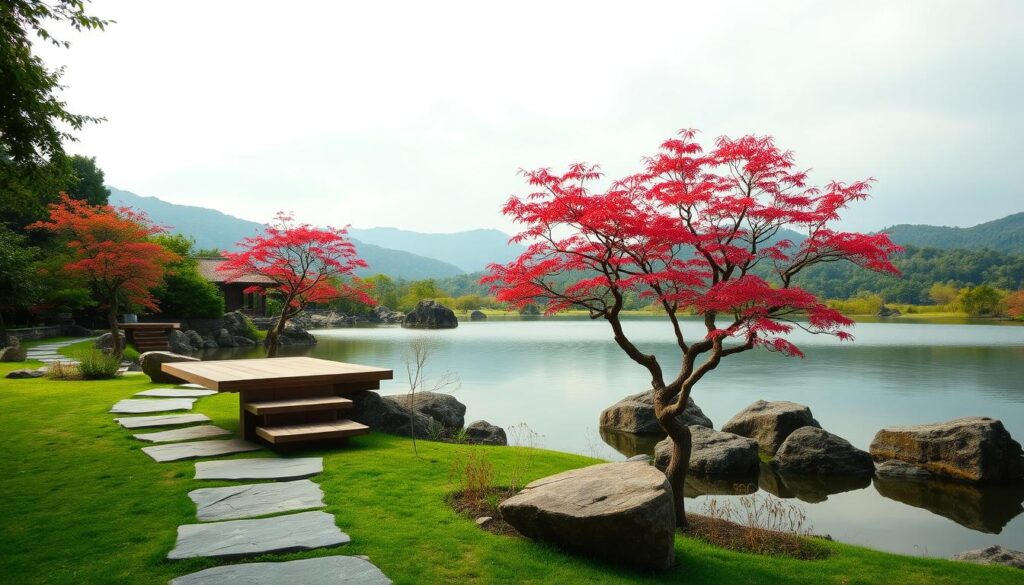
Balancing Natural and Created Elements
To make a meditation garden peaceful, it’s important to mix natural and made elements. Use native plants, natural materials for seating and paths, and avoid synthetic stuff. This balance makes the garden feel real and calm.
| Element | Description |
|---|---|
| Natural Elements | Plants, water features, and natural materials |
| Created Elements | Seating areas, pathways, and decorative features |
The Role of Sacred Geometry in Garden Design
Sacred geometry is important in meditation garden design. It brings harmony and balance. Using geometric patterns and shapes makes the garden feel sacred and peaceful. This can be done in seating areas, paths, and other features.
Choosing the Perfect Location for Your Practice Space
Finding the right spot for outdoor yoga and meditation is key. Even a small or urban area can be peaceful with the right setup. Think about sunlight, shade, and being near water.
A spot near a stream or fountain is great for a meditation garden. It adds a calming touch.
Here are some tips for a serene spot:
- Look for a place with gentle sunlight or shade.
- Stay away from loud noises and distractions.
- Add plants or water features for a natural feel.
A well-planned outdoor yoga area can be a peaceful spot, even in a busy city. By picking the right location and adding nature, you create a calm place. This place should reflect your inner self.
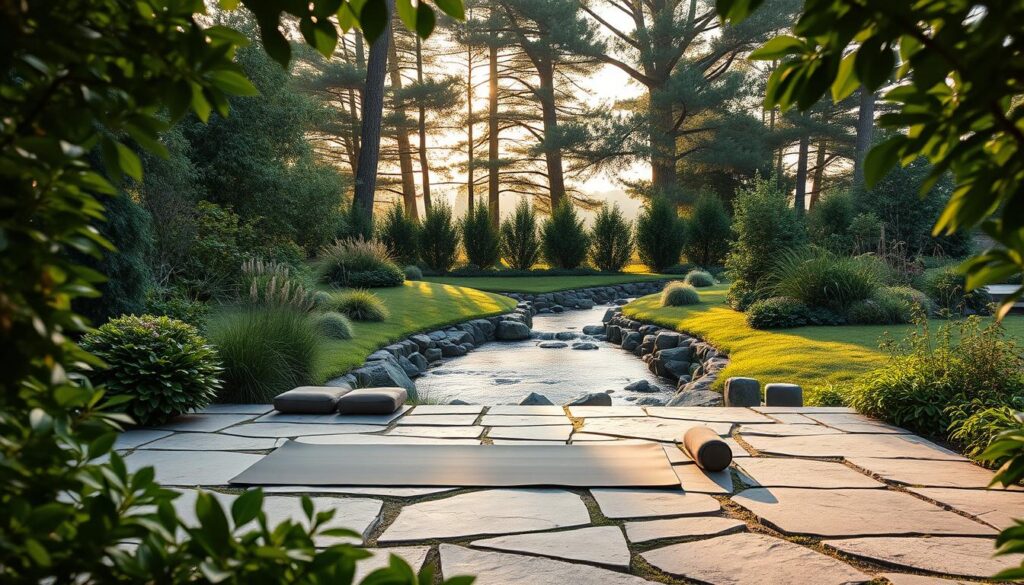
“The goal of meditation is to create a sense of inner peace and calm, and the right environment can greatly enhance this experience.”
Follow these tips and think about what you need. You can make a peaceful space for outdoor yoga and meditation. It’s perfect for deepening your mindfulness and connection with nature.
Fundamental Garden Ideas for Meditation Spaces
Creating a meditation space in your garden is a great way to relax and connect with nature. Think about adding elements that help you feel calm. Ideas like water features, walking paths, and seating areas can make your space peaceful.
Popular ideas include traditional Japanese gardens, modern minimalist designs, and Zen gardens. These styles use natural materials and simple designs to create a calm atmosphere. They help you find inner peace and relaxation.
Traditional Japanese Garden Elements
Elements like stone lanterns, bamboo, and bonsai trees bring serenity to your space. They use natural materials and simple designs for a calming effect.
Modern Minimalist Approaches
Modern minimalist gardens also offer a peaceful vibe. They focus on simple lines, minimal decoration, and natural materials. This style promotes relaxation and inner peace.
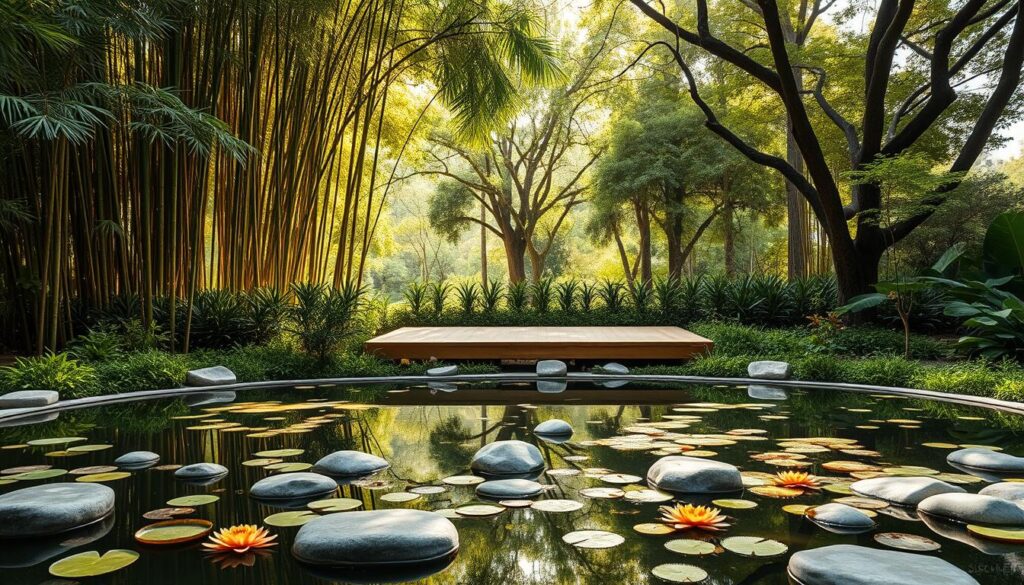
Zen Garden Concepts
Zen gardens, with raked gravel and stones, create calmness and tranquility. They use natural materials and simple designs for a peaceful atmosphere.
Using these garden ideas, you can make a meditation space that’s peaceful and calming. Whether you like traditional Japanese, modern minimalist, or Zen gardens, there’s a style for everyone. These ideas help you create a space that promotes relaxation and inner peace.
| Garden Style | Elements | Benefits |
|---|---|---|
| Traditional Japanese | Stone lanterns, bamboo, bonsai trees | Serenity, calmness, peace |
| Modern Minimalist | Simple lines, minimal ornamentation, natural materials | Relaxation, inner peace, calmness |
| Zen Garden | Raked gravel, carefully placed stones | Calmness, tranquility, inner peace |
Creating Privacy in Your Outdoor Sanctuary
Creating privacy is key when designing an outdoor sanctuary. It helps make the space peaceful and intimate. Natural screens and structural solutions can help achieve this. An outdoor sanctuary is a place to escape daily life’s noise, and privacy is vital for a secluded feel.
Natural Screen Options
Plants and trees can turn an outdoor space into a private retreat. Here are some great options:
- Bamboo plants, which can grow up to 10 feet tall and provide a dense screen
- Arborvitae trees, which can grow up to 20 feet tall and provide a natural barrier
- English ivy, which can be trained to climb up walls or trellises to create a screen
Structural Privacy Solutions
Structures like fences and walls also offer privacy. They can be tailored to fit your space’s style and needs. For instance, a wooden fence can blend with the landscape, while a stone wall adds solidity.

Using natural screens and structures, you can make a private outdoor space. This space is perfect for meditation, yoga, or just unwinding. It’s a crucial part of any outdoor sanctuary.
| Privacy Solution | Description |
|---|---|
| Natural Screen Options | Plants and trees used to create a sense of privacy |
| Structural Privacy Solutions | Fences and walls used to create a sense of privacy |
Selecting Plants for Mindful Gardens
When designing mindful gardens, picking the right plants is key. Plants greatly affect our well-being. The right plants can make meditation better. For a mindful garden, choose plants that bring calm and peace.
Native plants, succulents, and low-maintenance plants are great for mindful gardens. They’re easy to care for and connect us to nature. Here are some tips for picking plants for your mindful garden:
- Choose plants with soft, gentle textures and calming colors
- Select plants with a soothing fragrance, such as lavender or chamomile
- Consider using plants with a natural, organic shape to create a sense of harmony
By adding these plants to your mindful garden, you’ll make a peaceful space. This space will help you relax and meditate better. Make sure to pick plants that fit your climate and need little care.
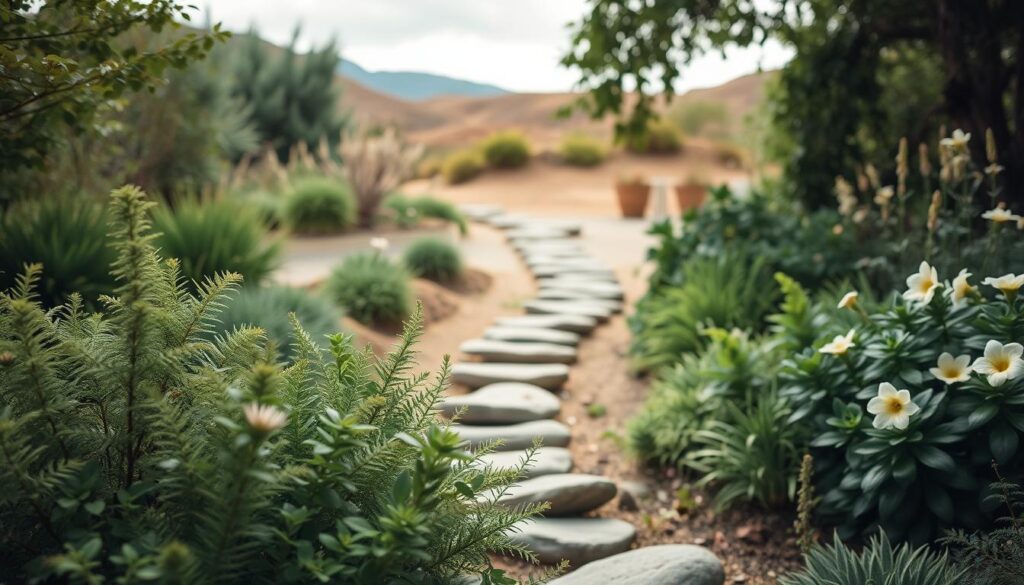
In a mindful garden, we aim for balance and harmony. By choosing the right plants, you can make a calming space. This space will help you relax, meditate, and connect with nature more deeply.
Incorporating Water Features for Tranquility
Water features are key to a peaceful meditation garden. The sound of flowing water can block out background noise. This creates a calm and serene atmosphere.
When adding water features, think about what fits your space best. Fountains add drama, ponds support plants and animals, and streams guide the eye.
Types of Water Features
- Fountains: perfect for small spaces, can be customized to fit your style
- Ponds: provide a habitat for aquatic plants and animals, can be used for reflection and contemplation
- Streams: create a sense of movement and flow, can be used to guide the eye through the garden
Choose a water feature that’s easy to maintain and sounds right. Regular upkeep keeps it clean and working well. The sound of the water is also important for the garden’s feel. Adding water features brings peace and calm to your meditation garden.
Maintenance Requirements
Keep your water feature clean and working with regular maintenance. This includes cleaning the pump and filter, checking the water level, and removing debris.
Sound Considerations
The sound of your water feature matters a lot. A soft, calming sound helps create peace. But a loud or harsh sound can be off-putting.
| Water Feature | Maintenance Requirements | Sound Considerations |
|---|---|---|
| Fountains | Regular cleaning of pump and filter | Gentle, soothing sound |
| Ponds | Regular water testing and maintenance | Calm, peaceful sound |
| Streams | Regular cleaning of stream bed and surrounding area | Gentle, flowing sound |
Designing Your Yoga Practice Area
Creating a yoga practice area is all about design. A well-designed space can help you focus and relax. It should be functional, comfortable, and look good.
Choosing the right surface is key. This includes flooring and yoga mats. The surface should support and grip well. Popular choices are hardwood, cork, and rubber.
Surface Requirements
There are important factors for the surface. It should last long and be easy to clean. It must also be safe to prevent falls. And it should be comfy to practice on.
Space Planning
Planning the space is crucial. Think about the size and layout. You want a peaceful area with enough room to move. Tips include using mirrors and adding plants.
By focusing on these design elements, you can make a space that’s both useful and beautiful. It will improve your yoga practice.
| Design Element | Considerations |
|---|---|
| Surface | Durability, slip-resistance, comfort |
| Space Planning | Size and layout, furniture and equipment placement, ambiance |
Lighting Your Outdoor Wellness Space
Outdoor lighting is key to a peaceful outdoor wellness space. It sets the mood, especially in the evening. A good lighting system turns your outdoor area into a cozy wellness space for relaxation.
Use both natural and artificial light. During the day, plants and water features reflect sunlight. At night, artificial lighting like string lights or lanterns create a warm glow.
Here are some outdoor lighting ideas for a wellness space:
- String lights or fairy lights for a magical feel
- Lanterns or candles for a soft, warm light
- Solar-powered lights for paths or special features
These outdoor lighting ideas make your wellness space peaceful and inviting. They help you relax and feel calm, even at night.
Adding Meditative Seating Areas
Creating a meditation garden is more than picking plants and water features. It’s also about adding elements that help you relax and think deeply. Meditative seating areas are key, offering a cozy spot to sit, reflect, and enjoy nature. It’s important to pick outdoor furniture that fits well with the garden and helps you feel calm.
A good meditative seating area can be made with traditional or modern furniture. You might choose benches, stools, hammocks, or daybeds. The goal is to make a space that encourages you to be mindful and peaceful. Some great options include:
- Benches made from natural materials, such as wood or stone
- Hammocks or swings that gently sway in the breeze
- Daybeds or chaise lounges that provide a comfortable spot to recline
When picking furniture for your seating area, think about how durable and easy to clean it is. Look for weather-resistant and low-maintenance materials, like recycled plastic or sustainably sourced wood. Adding meditative seating to your garden makes it a peaceful place for relaxation and thought.
Small Space Garden Solutions for Urban Areas
Creating a peaceful outdoor space in urban areas can be tough, especially with small gardens. But, the right design ideas can turn even the smallest areas into serene spots. Small gardens in cities offer a much-needed break from city life’s hustle.
Vertical Garden Options
Using vertical garden options is a smart way to save space. Think trellises, wall-mounted planters, and living walls. These not only save space but also bring greenery, making the area feel calm and peaceful.
Multi-functional Design Ideas
Another smart idea is to use multi-functional designs. For example, a garden bench can also hold gardening tools. This design saves space and adds usefulness, making the area more enjoyable.
| Design Idea | Benefits |
|---|---|
| Vertical Garden | Maximizes space, adds greenery |
| Multi-functional Design | Saves space, adds functionality |
By using these small space garden solutions, people can create peaceful outdoor spaces in cities. These spaces offer a much-needed break from city life’s stresses.
Weather Protection and Seasonal Considerations
When designing a meditation garden, it’s key to think about weather protection and seasonal considerations. This ensures the space stays comfy and useful all year. You can add things like umbrellas, canopies, or gazebos to keep it calm.
A good meditation garden can handle different weather, like rain, sun, and cold. With the right weather protection, you can enjoy it any time of the year. Important things to think about include:
- Using waterproof materials for seating and flooring
- Adding shading, like trees or canopies, to block sunlight
- Putting in drainage to stop water from gathering
Also, seasonal considerations are vital for a meditation garden. This means getting ready for each season and weather. For example:
By keeping these in mind, you can make a meditation garden that’s a peaceful spot all year. It’s a calm place to get away from daily stress.
Incorporating Sound Elements
A meditation garden is more than just pretty views. It’s about creating a peaceful space that touches all senses. Sound elements are key to making a meditation garden truly special. They help create a calm and serene atmosphere, perfect for meditation and unwinding.
In a meditation garden, sound elements can block out background noise, making it quiet. This can be done with wind chimes, bells, or water features. The sound of water flowing or wind chimes ringing softly can be very soothing. It helps calm the mind and promotes relaxation.
Wind Chimes and Bells
Wind chimes and bells are common in meditation gardens. They come in many shapes, sizes, and materials. This lets you pick the ones that match your garden’s look and feel. The calming sound they make helps bring peace and tranquility.
Natural Sound Enhancement
Another way to add sound to your meditation garden is through natural enhancement. This can be done by attracting birds and wildlife or using water features like fountains or ponds. The sounds of birds singing or water flowing can be very calming. They help create a calm and relaxing atmosphere.
Adding sound elements to your meditation garden makes it a peaceful and calming place. Whether you use wind chimes, bells, or natural sounds, the goal is to create a sense of tranquility. This engages all senses and helps you connect with nature.
| Sound Element | Description |
|---|---|
| Wind Chimes | Produce a soft, calming sound when blown by the wind |
| Bells | Produce a gentle, ringing sound when blown by the wind or struck by a mallet |
| Water Features | Produce a soothing sound of gently flowing water |
Sustainable Garden Practices
Creating a meditation garden that’s peaceful and eco-friendly boosts well-being and sustainability. By using sustainable garden practices, you can lower your carbon footprint. This makes your garden a natural haven.
Choosing eco-friendly materials is key to sustainable gardening. Options include recycled plastic, natural stone, and wood from sustainable sources. These choices help cut down on waste and lessen environmental harm.
Water Conservation Methods
Water conservation is vital in sustainable gardening. Rainwater harvesting systems and drip irrigation are great tools. They save water and ensure plants get the right moisture.
- Use native plants that need less water and care.
- Make a compost pile to turn food waste into fertilizer.
- Use solar-powered lights and pumps to cut energy use.
| Material | Benefits |
|---|---|
| Recycled Plastic | Durable, low maintenance, and reduces waste |
| Natural Stone | Sustainable, durable, and aesthetically pleasing |
| Sustainably Sourced Wood | Renewable, durable, and reduces deforestation |
Maintaining Your Meditation Garden
Keeping your meditation garden in good shape is key to a peaceful spot. Tasks like pruning and weeding keep it looking great. They also help you feel calm.
To make your garden easy to care for, try these tips:
- Choose plants that are native to your area and need little care
- Use green materials and methods to lessen harm to the environment
- Stick to a regular care plan to stop overgrowth and keep the garden looking nice
Seasonal care is also important to keep your garden calm all year. You might need to prepare it for cold winters or hot summers. Adjust your garden’s look and care plan as needed.
By focusing on meditation garden maintenance and upkeep, you can make a peaceful and green outdoor space. It will help you relax and feel better.
Budget-Friendly Design Options
Creating a meditation garden doesn’t have to cost a lot. With some creativity, you can make a beautiful and functional space without spending a lot. You can build your own planters and benches to make your garden unique.
When planning your garden, think about what you really need. Maybe you want a nice water feature like a fountain. This can be a big part of your budget.
DIY Elements
DIY projects can make your garden special and save money. Here are some ideas:
- Make planters from reclaimed wood or terracotta pots
- Use stones or pebbles to create a mosaic pathway
- Design your own meditation bench or seating area
Phased Implementation Plans
Another way to save money is to do your garden in phases. This way, you can pay for it over time. Start with the basics like a place to sit and a water feature. Then, add more things like planters and sculptures as you can.
By using DIY projects and planning in phases, you can have a beautiful meditation garden without spending too much. Focus on what’s most important to you and your meditation practice.
| Element | Cost | Priority |
|---|---|---|
| Water feature | $500-$1000 | High |
| Seating area | $200-$500 | Medium |
| Planters and sculptures | $100-$300 | Low |
Conclusion: Creating Your Personal Paradise
Starting your meditation garden journey is exciting. It’s your own peaceful place where you can relax and connect with nature. By using the tips we shared, you can make a space that shows your style and meets your needs for calm and focus.
Even if you have a small area, you can still create a meditation garden. With some planning and creativity, you can turn any spot into a peaceful retreat. This can be done with plants, water, and natural materials.
Your meditation garden will grow and change as you do. Be open to trying new things and let your space evolve with you. By taking care of this special area, you’ll enjoy the many benefits of outdoor meditation and find your own personal paradise.
FAQ
What are the essential components for creating a spiritual garden?
To create a spiritual garden, start with natural elements like plants and water features. Add seating areas to promote calm and well-being. Balance natural and created elements and use sacred geometry.
How do I choose the perfect location for my yoga and meditation practice space?
Look for a spot with good sunlight and shade. Being close to water features is also beneficial. Even in small or urban areas, aim for a peaceful and secluded spot.
What types of plants are best for a mindful garden?
Choose native plants and succulents for a mindful garden. They are low-maintenance and promote calm. Selecting plants carefully can create a peaceful atmosphere.
How can I incorporate water features to enhance the tranquility of my meditation garden?
Water features like fountains and ponds add tranquility. Consider maintenance and sound to create a calming space.
What are some traditional and contemporary seating options for a meditative space?
Traditional options include benches and stools. Contemporary choices are hammocks and daybeds. Choose seating that invites relaxation and contemplation.
How can I create a peaceful and functional outdoor space in a small or urban area?
Use vertical gardens and multi-functional designs in small spaces. For example, a garden bench can also store items. With planning, you can create a serene outdoor space.
How can I incorporate sustainable practices into my meditation garden?
Use eco-friendly materials and water conservation methods. This includes recycled materials and rainwater harvesting. These practices make your garden environmentally friendly.
What are some budget-friendly design options for a meditation garden?
Use DIY projects and phased plans to save money. Building your own planters and benches is cost-effective. With creativity, you can create a beautiful garden on a budget.

